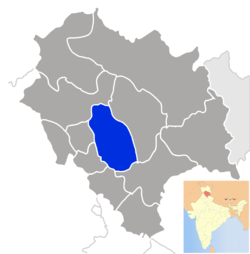Mandi district
|
Mandi district मंडी |
|
|---|---|
| District of Himachal Pradesh | |
 Location of Mandi district in Himachal Pradesh |
|
| Country | India |
| State | Himachal Pradesh |
| Headquarters | Mandi, India |
| Area | |
| • Total | 3,951 km2 (1,525 sq mi) |
| Population (2001) | |
| • Total | 900,987 |
| • Density | 230/km2 (590/sq mi) |
| Major highways | NH21 |
| Website | Official website |
Mandi district (earlier known as Mandavya Nagar) is one of the central districts of Himachal Pradesh state in northern India. Mandi town is the headquarters of Mandi district. The town has mythological and historical significance and boasts of a unique temple architecture. It is referred to as Chhota Kashi as there are many ancient temples in the city and on the banks of river Beas. The Beas flows through the town and hills, which makes this town more scenic. It has a serene ambiance though the modern development has made its inroads here in infrastructural developments.
The town is an important commercial hub of the state. It is a major transit route to Kullu-Manali and other adjoining places from NH-21 (Chandigarh-Manali highway) and NH-20 (Pathankot-Mandi highway). Sundarnagar is one of the emerging towns of the district.
Mandi has an educated middle class and people converse in Mandyali, one of the Pahari languages of Himachal.
As of 2011 it is the second most populous district of Himachal Pradesh (out of 12), after Kangra.
Mandi district was formed after the merger of Mandi State (Mandi) and Suket State, two princely states on 15 April 1948. This coincided with the formation of the Union territory of Himachal Pradesh. The state attained its full statehood later. Mandi town was named after its resident saint Mandavya Rishi.
Mandi is almost at the geographical centre of Himachal, lying along the left bank of the river Beas in the foothills of Shivalik ranges. The town has an altitude of 760 metres (2,495 ft) from the sea level. Comprising the two erstwhile states of Mandi and Suket, Mandi derives its name 'mandi' or 'market' as it was a major trade route from Ladhakh to locations in Punjab such as Hoshiarpur and other places.
Here, during the days of yore, the pious rishi, Mandavaya, performed long and severe penance and practised austerities on his body, on the bank of the river Beas, near the present Mandi town. The story indicates the antiquity of this beautiful temple town, surrounded by hills, clad in pines. There is a large plain which has grain fields and orchards, between Mandi and Sundernagar. Known for its temples, Mandi is the home to a number of beautiful carved stone edifices each with an elaborate shikhara, or spire, among them Bhutnath, Trilokinath, Panchvaktra and Shyamakoli at Tarna hill. Also on the hill, there is a new temple dedicated to Tarna Devi, overlooking the valley and giving a panoramic view. The Beas valley is broad near Mandi, and there are a number of striking vales such as those of Uhl and Ran Khad.
...
Wikipedia
